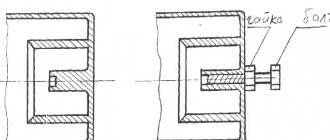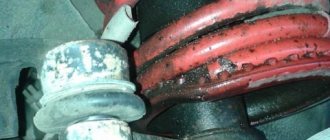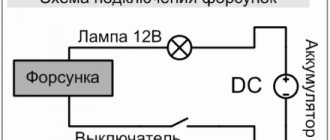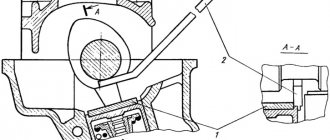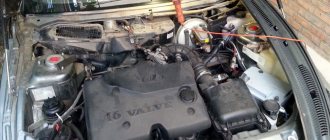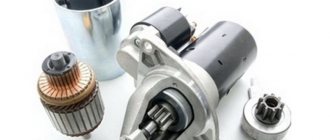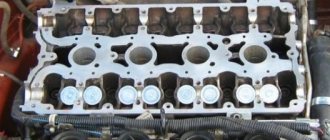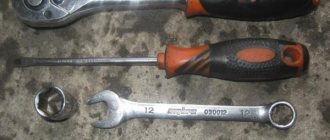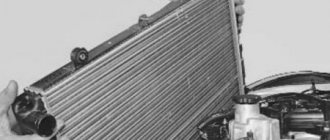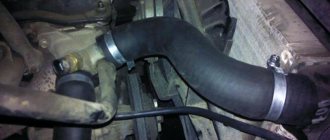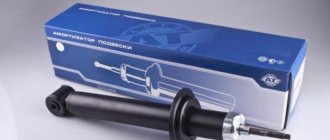How to replace antifreeze on a VAZ 2110,2112 yourself
First, let's find out why we need to replace coolant on a VAZ 2110 if we constantly monitor its level and regularly top it up to the mark on the expansion tank. But it's not that simple. It is important to know that antifreeze, after prolonged use in the cooling system, changes its properties. If this is not critical in the summer, then in winter it can freeze and rupture both the radiator and the cylinder block. Long-term operation of the coolant is considered to be a mileage of more than 70 thousand kilometers or 4-5 years of operation. So let's get started.
- It is necessary to replace antifreeze only when the engine has cooled down.
- Coolant is an active chemical, so you need to be careful when changing it.
- Before starting the engine, make sure that the expansion tank cap is tightly closed.
1. It is best to replace antifreeze on an overpass or pit intended for repairs, so that there is free access to the bottom. But if this is not possible, then we place the car on a flat surface. If the site has a slope, then we park the car so that the slope is backwards. 2. Disconnect the wire from the battery terminal. 3. Before starting to replace the antifreeze, make sure that the engine has cooled down sufficiently. 4. To get to the drain hole on the cylinder block of model 2111, remove the ignition module along with the bracket (Fig. 1).
5. Next, remove the cap of the expansion tank so that a vacuum does not form in the cooling system and the antifreeze comes out completely (Fig. 2).
6. Place a container for draining the coolant under the cylinder block and unscrew the drain plug on the cylinder block. After the antifreeze is completely released, we wipe the cylinder block from antifreeze residues (Fig. 3).
7.Next, install the drain container under the cooling radiator. We unscrew the drain plug on the radiator and wait until the antifreeze is completely out of the cooling system (Fig. 4).
8.If you have an injection system, then loosen and tighten the clamp and disconnect the antifreeze supply hose from the throttle pipe heating fitting (Fig. 5).
If you have a carburetor, then disconnect the hose from the carburetor heating fitting (Fig. 6)
This procedure is necessary so that when the coolant fills the cooling system, air comes out of it and an air lock does not form. 9. Fill the cooling system by pouring antifreeze into the expansion tank until its level is at the top edge of the fastening belt. Screw on the expansion tank cap. The cap of the expansion tank must be screwed on tightly, because when the engine is running, the tank is under pressure and antifreeze may leak from under the plug, or it may simply be torn off (Fig. 7)
10. We connect the hoses, depending on the model, to the heating fitting of the throttle pipe or carburetor 11. On the cylinder block of model 2111, we install the ignition module in place. 12. Connect the wire to the battery terminal. 13. Next, start the car, let it warm up to operating temperature and turn it off. Check the coolant level and, if necessary, add to the level
When starting the engine for the first time, after replacing antifreeze on a VAZ 2110, 2112, it is necessary to monitor the coolant temperature. If the temperature gauge needle moves to the red zone and the fan does not turn on, turn on the heater and check what kind of air flows through it. If it is heated, then most likely the fan is faulty; if it is cold, then an air lock has formed in the cooling system.
Let's get started
First you need to place the machine on a flat surface. It is advisable that this be an inspection hole (if there is none, we take a jack). We need the latter in order to get to the fluid drain bolt.
It is located in the cylinder block, near the plug. To unscrew it, use a ratchet with a 13mm head.
Don’t forget to place a basin, bucket or canister under the cork. To increase the pressure of the liquid, unscrew the plastic cap on the expansion tank. This can cause a vacuum to form in the system. Further the flow of antifreeze will increase. After draining, screw the plug back in with a wrench. We take the funnel in our hands and install it in the neck of the expansion tank. Pour antifreeze from the canister. Do not pour in large portions - this will allow air into the system, the presence of which is undesirable. Then we check the system for the presence of traffic jams. To do this, press the rubber radiator pipe several times. It will gurgle at first. This means that air is coming out of it. For better effect, you can raise the car even higher. This will remove all unnecessary oxygen. Then close the hood and turn on the engine. After three minutes, turn it off and check the fluid level again. As a rule, after warming up, some of the antifreeze leaves the tank. Therefore, we top up to the mark between the maximum and minimum. At this point, the replacement of antifreeze on a VAZ-2110 (8 valves) has been successfully completed. It doesn't matter whether it's an injector or a carburetor. The system is the same and has not changed on the “tens” for years. Therefore, this instruction can be used for VAZs of different years of production with different engine sizes.
How to remove an air lock from the cooling system of a VAZ 2110, 2112
1.If the car has recently been running, then you need to wait until it cools down. 2.Unscrew the cap of the expansion tank, only with the engine cooled down, otherwise antifreeze under pressure may splash out. 3. Disconnect the coolant supply hose from the throttle pipe heating fitting if you have an injector
Or disconnect the hose from the carburetor heating fitting if you have a carburetor
4. Fill the antifreeze into the expansion tank to level 5. Attach the hose back.
Engine starting
After all the operations performed, close the expansion tank cap, install the protection on the engine, put the negative terminal back on and start the engine. As the engine warms up, antifreeze should come out of the return line - this is a sign that the antifreeze has been replaced correctly. The engine must be warmed up until the radiator cooling fan turns on. After turning on the fan, place your hand against the heater radiator, next to the fan. The radiator will be warm if everything is done correctly.
The fan turns on - the temperature drops
If the radiator is cold, there may be two reasons for this - not all the air has left the system or a faulty thermostat. Also a good sign will be hot air from the heater in the cabin. One more thing - while warming up the engine, check the tightness of the entire cooling system. If leaks are detected, the pipes will need to be replaced.
Important – control the tightness of all connections
Replacement of antifreeze in VAZ 2112 has been completed. Bottom line - after you have checked everything and found no bad signs, you can safely close the hood and hit the road. Bon Voyage!
Source: https://masteravaza.ru/sistema-ohlazhdeniya-dvigatelya/obsluzhivanie/vaz-2112-zamena-tosola-414
How to change antifreeze on a VAZ 2110 with your own hands
Replacing antifreeze on a VAZ 2110 is a very important procedure. Coolant is very important to the operation of any vehicle. Without this fluid, the car simply cannot function fully. During operation, the engine gets very hot, and without antifreeze, it boils. Also, antifreeze protects the engine itself well from corrosion, which greatly increases the life expectancy of the car.
WHY CHANGE ANTIFLEGE AND HOW OFTEN DO IT?
Let's start by answering the first question - do you need to change antifreeze and why change it? The answer is clear - it needs to be changed, since it, like everything else, has the excellent ability to lose its properties.
VAZ 2112 how to replace antifreeze
Plus, the loss of the quality of the liquid occurs not only from the expiration date, but also from the fact that it is in an engine that is subject to corrosion - that is, the antifreeze becomes brown or red.
How often is it necessary to replace antifreeze on a VAZ 2112? According to official data, this must be done every 2 years or every 45 thousand km. Some advise changing every year.
This is often not necessary. If the car is old and “leaks” every winter, then this can be done. But the VAZ 2112 is not a rare car, so once every two years will be enough. How else can you determine that antifreeze needs to be changed? This can be done by color.
Looking into the expansion tank, see what color the antifreeze has become. Pure antifreeze has a bright blue color. Black and red color is a clear indicator of the need for replacement.
Antifreeze should have the color as in the photo
Possible reasons for replacing antifreeze on a VAZ 2110
Antifreeze lasts quite a long time. But he also has his limit. On the VAZ 2110 this period is limited to 150 thousand kilometers. But in real life, replacing antifreeze may be necessary much earlier.
Reasons for replacing antifreeze
- The color of the antifreeze has changed a lot. It looks like it has rusted. You can see the color of the antifreeze through the expansion tank;
- A strange oil film appeared on the surface of the antifreeze itself in the expansion tank. This is clearly not a sign of good condition of the antifreeze;
- While driving, the car engine begins to overheat very quickly and the coolant boils. This problem may occur due to a faulty fan. But it’s best to protect your car and change the antifreeze. If this does not help, the problem is definitely in the fan;
- Also, perhaps there is simply not enough antifreeze. This happens when antifreeze leaks somewhere. Perhaps some clamp is damaged. Usually, holes are not visible and are difficult to find. But it is the clamps that are the very weak point in this entire system. Antifreeze can leave unnoticed. When checking the level, it will be almost the same. But while the machine is running, the liquid still boils. This means that an air lock has formed inside due to a leak. In this case, replacing the antifreeze will not help and the problem will not go away.
Helpful advice
When replacing antifreeze on a VAZ-2110 car, it is worth inspecting the condition of the pipes and hoses that go to the radiator and expansion tank. Characteristic signs of wear are:
- Cracks.
- Cuts.
- Low elasticity.
If the pipe is cracked and hard to the touch, then it needs to be replaced. The clamps are also changed. They can be bought at any hardware store. The hoses themselves that go to the tank must be reinforced, as in the photo below.
Conventional rubber products quickly become unusable or fray. If there are cracks on the tank itself, we also replace it with a new one. It would be a good idea to check the thermostat as well.
If it is stuck in one position, it should be replaced. You can check this by boiling the element in a saucepan on the stove. Why does this work need to be done when replacing the coolant?
Because during any operation related to the cooling system, you will have to drain the antifreeze again. And this is an additional waste of time and effort.
Preparing to replace antifreeze
Before changing antifreeze, you need to drain the old one, and this is completely logical. In total, the tank contains approximately 7.8 liters of antifreeze. You can drain 7 liters without any problems. This means that for replacement you will need only 7 liters of fresh antifreeze.
Choosing antifreeze important features:
- It is best to buy antifreeze from one manufacturer. If there is a strong difference in composition, the mixture in the tank may not be very good. And this can damage the health of the car.
- You need to pay attention to the type of liquid. If it is a concentrate, then it will definitely need to be diluted.
- It is necessary to replace the coolant after the car has completely cooled down. And it will be possible to start the car only when everything is finally connected and checked for leaks. Otherwise all the problems will come out again.
Optimal coolant option
When you have figured out how to replace antifreeze on a VAZ 2110 (2112), it is important to choose the optimal fluid option. Many car enthusiasts only use expensive antifreeze, considering it to be of higher quality.
For VAZ cars, it is quite possible to use a cheap domestic product - antifreeze, the characteristics of which were developed specifically for these cars.
Owners of domestic cars respond positively to Felix brand antifreeze. It is sold in canisters of 5 and 10 liters, and smaller containers. It is profitable to purchase liquid in a 10 kg container - it is cheaper, and after replacing the used antifreeze, there is still liquid left for refilling.
How to change antifreeze on a VAZ 2110
Before replacing the antifreeze, you must drain the old one. Draining antifreeze from a VAZ 2110 is quite simple. The whole process takes only 6 steps.
Absolutely any car enthusiast who has just bought a car can handle this:
- First step. Before you start draining, be sure to wear protective gloves and goggles. Also, be sure to wait until the car cools down.
- Second step. The car must be placed on a flat surface. But those who have owned a car for a very long time believe that the car should be parked at a slight angle. This is how you can drain the maximum amount of antifreeze.
- Third step. It is necessary to de-energize the vehicle system. To do this, you just need to disconnect the negative terminal from the battery.
- Fourth step. Now you need to remove the ignition module, along with the bracket. This will open access to the cylinder block. After this, you need to place containers under the drain plug so that the old antifreeze flows there.
- Fifth step. First you need to unscrew the cap of the expansion tank. So, when draining the antifreeze, additional pressure will appear, and draining will be much easier.
- Sixth step. Now you can start draining the antifreeze. To do this, you need to remember to place a bucket under the radiator; the more liquid that drains, the better. Having done all this, you can remove the second plug, starting to drain.
- Seventh step. When it becomes clear that the fluid is no longer flowing, you can begin to replace it. But before that you need to prepare everything. You need to check all the fittings of the pipes, wipe all the plugs and drains.
- Eighth step. In order to fully prepare the car for the new antifreeze, you need to take into account absolutely all the nuances. If the car is on an injector, you need to disconnect the hose at the junction with the fitting. If the car has a carburetor, you must also disconnect this hose. These actions are necessary to ensure that when pouring new antifreeze, air pockets do not form, which will lead to a new breakdown.
- Ninth step. You need to find out exactly how much antifreeze you need to fill. The filling process must be carried out by removing the cap of the expansion tank. Through it, the antifreeze level will be clearly visible and it will be easier to determine how much antifreeze needs to be poured. It is best to pour in the same amount of antifreeze as was drained.
After all these steps, you need to tightly close the plug and connect the hose back. Then reconnect the ignition module and return the battery terminal to its place. Now you need to start the car and let it work. If after turning on the antifreeze level drops, you just need to add more. If everything has been checked, there cannot be a leak. Most likely, the plug was simply pressed through; this is a completely normal phenomenon that you should not be afraid of.
Operating procedure
Draining old coolant
DIY pump replacement for Lada Priora 8 and 16 valves
If the replacement is made on a lift or inspection pit, it is necessary to remove the engine protection, if any. When replacing without a pit, you don’t have to remove the protection, but then old antifreeze will get on the protection. There is nothing dangerous about this, but for a few days after the replacement, you may smell antifreeze until it evaporates. We place a drain container under the lower right side of the radiator, if conditions permit.
If you are not changing it in an equipped place and you do not need the old antifreeze, you can simply dump it on the ground. Many people advise initially opening the cap of the expansion tank, then unscrewing the plug at the bottom of the radiator to drain, but in this case old antifreeze under high pressure, especially if the engine has not completely cooled down, will flow out of the radiator. It is safer and more convenient to first unscrew the cap (plastic wing) of the radiator, the old antifreeze will flow in a thin stream, then carefully unscrew the cap of the expansion tank, thereby, due to the tightness in the cooling system, you will be able to regulate the antifreeze drain pressure.
Draining antifreeze VAZ 2110
After draining the antifreeze from the radiator, we need to drain the liquid from the engine cylinder block. The peculiarity of draining antifreeze on a VAZ 2110 from the cylinder block is that the plug on the block is closed by the ignition coil (on a 16-valve injection engine). To do this, we need to dismantle it, use a 17mm wrench to unscrew the bottom bolt of the coil bracket, use a 13mm wrench to unscrew the side and central bolts securing the bracket and move the coil to the side. Using a 13 key, unscrew the drain plug from the cylinder block. To more completely remove old antifreeze, you can connect an air compressor and apply air pressure through the filler neck of the expansion tank.
We tighten the plug of the cylinder block and the plug on the radiator (the plug on the radiator is plastic with a rubber gasket, it can be tightened by hand without unnecessary force; for reliability, you can coat the threads of the plug with sealant). We put back the ignition coil.
Filling with new coolant
Before adding new antifreeze to the VAZ 2110, it is necessary to disconnect the heating hose to the throttle valve (for an injection engine), or the hose from the carburetor heating fitting (on a carburetor engine), so that excess air can escape from the cooling system. Fill in new antifreeze to the level of the upper part of the fastening of the rubber belt of the expansion tank. We connect the hoses to the throttle valve or carburetor, depending on the model. Close the expansion tank cap tightly. Open the heater tap in the cabin to the hot position.
Filling antifreeze into a VAZ 2110
Starting the engine
Immediately after starting the engine on a VAZ 2110, you need to pay attention to the level of antifreeze in the expansion tank; it may immediately drop, this may mean that the water pump has pumped coolant into the system. We turn off the engine, top up the level and start again
We warm up the car. During warm-up, we check for leaks in the engine compartment, in places where hoses and plugs were removed. We monitor the engine temperature.
When the operating temperature reaches 90 degrees, turn on the heater; if it heats with warm air, turn it off and wait for the engine cooling fan to turn on. When you turn on the fan, wait for it to turn off, turn off the engine, wait 10 minutes for the engine to cool down a little, unscrew the cap of the expansion tank, check the coolant level, and add if necessary.
Coolant VAZ 2110: correct selection and replacement
Replacing (topping up) coolant in a VAZ 2110
The duration of use of the coolant (its service life) ranges from 120 thousand kilometers to 150 thousand kilometers; upon reaching such a mileage, it is necessary to replace the VAZ 2110 16 valve coolant. The main sign indicating the need to replace antifreeze (antifreeze) is the appearance of a rusty color in the coolant expansion tank, or an oil film, or any other deviations from its initial state. Replacing the coolant in a VAZ 2110 8 valve is a simple procedure, no different from replacing the antifreeze in a VAZ 2110 16 valve, and anyone can do it themselves.
Antifreeze
So:
- Antifreeze is produced using traditional technologies, which are already noticeably outdated.
- Such technologies allow the formation of a protective layer on the walls of cooling jackets up to 0.5 mm thick during operation. And considering the thickness of the shirts themselves, this is not so little!
- This very layer has low thermal conductivity, and therefore heat transfer. It turns out that the cooling system has to work longer at elevated temperatures.
- This leads to increased wear of unit parts, as well as increased gasoline consumption. Sediment can also cause the thermostat to jam.
- The advantage of antifreeze over other antifreezes is its price! It's much smaller!
- On the other hand, antifreeze is quite common in our area. It is widely used at technical stations. service by many masters.
- Taking into account the wear of engine parts and other possible breakdowns, we can say that antifreeze fully justifies itself as a coolant.
- Usually replaced after 30-40 thousand kilometers or 1 year of use of the car.
Note to car owners
Please know that if you do not replace the antifreeze in a timely manner, then premature corrosion begins in the channels of the engine block and its head and, as a result, the engine life is significantly reduced:
- This affects the cylinder head the most.
- Working as a car mechanic, I often had to disassemble engines and observe the head cooling channels eaten away by corrosion
- After such a spectacle, anyone will feel scared for their car; you will certainly forget to change the antifreeze in a timely manner.
- At each scheduled maintenance, you need to check the level and appearance of antifreeze (more often if possible)
Important: The antifreeze level must be checked on a cooled engine; the permissible level is within (between) the lower and upper marks on the body of your expansion tank. A slight increase or decrease in this level that occurs when it is cooled or heated is not considered a malfunction; this is absolutely normal. Such level fluctuations are associated with thermal changes in volume (for example, expansion when heated and subsequent decrease in volume when cooled). However, if you notice a gradual decrease in the level with each new check on a cold engine, then you need to look for where the leak is occurring.
Required amount of coolant for VAZ 2110
After a certain mileage and operation of the VAZ 2110 car, it is necessary to carry out a technical inspection, monitor the level of oil and coolant in the system. After a certain period of operation, all lubricants and coolants lose their original technical and operational characteristics and require replacement. Therefore, before replacing the coolant, you need to find out how much antifreeze is in the cooling system of the VAZ 2110.
ATTENTION! A completely simple way to reduce fuel consumption has been found! Don't believe me? An auto mechanic with 15 years of experience also didn’t believe it until he tried it. And now he saves 35,000 rubles a year on gasoline! Read more"
Many inexperienced car enthusiasts, when replacing antifreeze or antifreeze in a car's cooling system, fill in 5-6 liters of fluid and make sure that it has reached the maximum level in the expansion tank, consider this sufficient and close the hood of the car. This is their big mistake , since the antifreeze has not yet had time to completely fill the system. You need to wait about five minutes until the liquid level in the tank drops significantly. Accordingly, you will need to add more coolant.
We recommend: How to check the performance of the vacuum brake booster
This procedure must be done several times, only then will it be clear how many liters of antifreeze are in the VAZ 2110 cooling system. It is necessary to add fluid until its level stops at one mark, which should be above the minimum and below the maximum level. Not adding enough antifreeze or antifreeze can cause the engine to overheat and fail. It is also impossible to overfill coolant, since when heated it tends to increase in volume.
After pouring antifreeze (antifreeze), you need to perform the following steps:
- close the expansion tank cap;
- start the engine and wait until it warms up before turning on the fan;
- turn off the engine and let it cool down;
- Check the coolant level in the tank and top up if necessary.
A VAZ 2110 needs to be filled with approximately 8 liters of coolant. This is a rather important procedure on which the life of the car engine depends.
Choosing coolant
How your car's cooling system works depends on several factors, the main component of which, of course, remains the coolant (water, antifreeze or antifreeze). Not everyone understands that the quality of the liquid in the cooling system determines the stable operation of not only the motor and heater, but also other elements of the cooling system. Therefore, let's decide why antifreeze is better than ordinary water:
- Antifreeze has low specific expansion when heated
- higher boiling point
- Very low crystallization temperature (antifreeze does not freeze, it turns into a gel)
- Antifreeze protects the cooling system from corrosion
- In addition, it has anti-foam properties (practically does not foam)
- Has some lubricating properties (the SOD pump is lubricated with antifreeze)
How does antifreeze differ from antifreeze:
- Antifreeze is an antifreeze; it consists of ethylene glycol in 99% of cases.
- “TOSOL” received its name during the USSR (that’s how the new brand of antifreeze was called), after which it remained so. It turns out antifreeze is a Russian brand of antifreeze
- The antifreeze itself can be diluted or a concentrate (look at the label carefully), which must be diluted before using it in the car.
- The antifreeze resource is slightly longer due to modern additives that ensure a stable condition and inhibitors that prevent intense corrosion of all metal parts of the engine
What determines the quality of antifreeze:
- The quality of antifreeze is determined by the set of its additives; the properties of antifreeze depend on them
- Buy antifreeze in reliable branded stores from well-known manufacturers, and do not look for a cheap one, so as not to stumble upon a fake
- The color of high-quality antifreeze is not of fundamental importance
- However, you cannot change or add antifreeze of different colors, even if these antifreezes are produced by the same company
- It is all the more questionable to mix antifreezes of the same color, but from different manufacturers.
- Remember, the point is the additives added to the antifreeze, they differ, so no one knows how such a cocktail will behave when mixed
According to the regulations, antifreeze is replaced every five years, or look at the mileage indicated at the beginning of the article, but in practice these figures may differ, depending on the operating conditions of the car, as well as the quality of the antifreeze.
Characteristics of liquids
So let's start with the definition. What is antifreeze? This is a coolant developed by Soviet scientists in the 70s. It was this that was used for the first Zhiguli cars. Subsequently, the coolant began to be used on the VAZ-2110. The car rarely needed to replace antifreeze - only once every two years. But antifreeze has an even longer lifespan. Although the composition of both liquids is the same. They are based on ethylene glycol. Moreover, the coolant is not initially painted in any color. Subsequently, the manufacturer adds the appropriate additives:
- Anti-foam. To prevent air from forming in the system and reducing heat dissipation.
- Anti-corrosion. Over time, system components may rust. Dirt particles clog small channels and prevent normal fluid circulation. These additives are also called corrosion inhibitors.
The liquid also has an anti-scale additive.
When ordinary water boils, it forms a characteristic white coating on the walls. This significantly impairs heat dissipation. As a result, the machine heats up even with the fans on. If the coolant boils, it does so at a temperature of at least 105 degrees Celsius and does not emit deposits.
Preparing for replacement
Replacing antifreeze with your own hands begins as usual with choosing a tool:
- Heads “10” and “13” with ratchet and extension
- Phillips screwdriver
- If you have an engine from the 2111 model, then you need to remove the ignition module using keys “13” and “17”
- Empty container (bucket) for draining liquid
- Rags
What to consider
- When starting to replace the fluid in your car’s engine, just keep the engine cool and the temperature of the VAZ 2110 16 valve coolant can reach 100 degrees, otherwise you will definitely get burned and scalded
- Coolant (except water of course) is a chemical substance (very poisonous), it can harm your body and the environment, so do not taste it, do not inhale the fumes, do not get it into your eyes or skin
- It is recommended to change antifreeze slowly and wear rubber gloves.
- Do not pour antifreeze onto the ground, protect the environment
- If you have topped up antifreeze, do not start the car until you have screwed the expansion tank cap back into place.
Operating principle of SOD
The cooling system is closed and always works, no settings are required. Antifreeze is poured into the expansion tank. Most often, antifreeze or another coolant is used as a coolant. This is a solution of water with ethylene glycol, thanks to which the liquid does not freeze at low temperatures. The cooling system of the 10th family uses about 8 liters of coolant; it needs to be topped up if necessary. After reaching a mileage of 75,000 km, it is recommended to flush the system and change the coolant. The operating principle of the SOD can be divided into several stages:
- The circulation of the working fluid is carried out thanks to a centrifugal pump (pump). It is integrated into the cylinder block and driven by the timing belt.
- Circulating through the jacket of the cylinder block, the antifreeze begins to heat up from the parts that are heated as a result of the operation of the internal combustion engine. At this time, a sensor located right there measures the temperature of the coolant, which moves only along a small circuit. When the antifreeze heats up to 90 degrees, the thermostat valve opens slightly, allowing the liquid to circulate through a large circuit. This means that the coolant begins to pass through the main radiator, where it cools and returns to the system - this is how heat is removed. The small and large circuits operate in parallel. After the temperature rises to 102 degrees, circulation occurs only in a large circle.
Replacing antifreeze
The process of replacing antifreeze is very simple; our instructions will tell you what and where to unscrew. Follow the prescribed order of operations:
- The car must be placed on as level a surface as possible.
- If there is no horizontal platform, then position the front of the car higher than the rear
- Before starting work, the vehicle should be de-energized; the cost of negligence can be costly.
- Just disconnect the wires from the battery
- As often happens with the “creations” of the Volzhsky Automobile Plant, in order to get to one part (drain plug) we will have to remove another
- If the engine, as already mentioned, is model 2111, in order to calmly drain the antifreeze from the block, you need to unscrew the ignition module and its bracket
- To create an air flow into the cooling system, which will accelerate the drainage of liquid, it is necessary to remove the plug from the expansion tank, shown in the photo
Unscrew the cap from the tank to open air access to the system
- When we have gained access to the drain plug on the engine block, we place an empty container prepared in advance under the engine and then unscrew the plug
- Drain coolant carefully to avoid spilling this toxic chemical around the vehicle.
- After completing the operation, wipe the plug and the hole itself and around it with a clean rag.
We unscrew the drain plug, the container is already under the engine
- The next step is draining the fluid from the radiator
- Move the container under the radiator
- The procedure is similar to draining antifreeze from the block - you need to unscrew the plug and wait for the liquid to drain into the container
We unscrew the radiator cap so that the liquid drains into the container.
- After the liquid has completely drained and the cooling system has emptied, the plugs unscrewed from the radiator and block must be screwed into place
- If we mean a motor with a gasoline injection system, then you will need to loosen the clamp and pull off the antifreeze supply hose from the pipe where it connects to the throttle pipe fitting
Loosen the clamp and remove the antifreeze supply hose on the injector
- If we drained the coolant from the carburetor engine, then unscrew the hose from its connection with the carburetor heating fitting
Remove the pipe marked with a white arrow
- Such actions help avoid the appearance of the famous air locks that prevent fluid from filling the system evenly
- When filling the system with antifreeze, air will exit through these pipes and not get stuck in the system
- After the antifreeze has drained and before tightening the plugs, the cooling system is usually flushed with clean water, after which the plugs are tightened
- Then we fill the system with new coolant
- It is poured through the expansion tank until the level is level with the upper limit of the belt securing the tank
- After filling, screw the expansion tank cap into place.
- The hose that we unscrewed to bleed air is now returned to its place and screwed to the heating fitting
- Then (if you had to remove it) you need to put back the ignition module, which was preventing you from getting to the drain plug
- Then we connect the battery contacts
- Start the engine and warm it up
- Sometimes warming up can help push through any air pockets that have arisen, then the liquid leaves the tank
- When this happens, you need to turn off the engine and add coolant to the required level.
Cooling system of a 16-valve Lada Priora engine
The cooling system of the Lada Priora is typical for representatives of AvtoVAZ power units - liquid, closed type. It is practically no different from the standard 8-valve power unit.
Description of the cooling system
The Priora engine cooling system is of a liquid closed type. It includes a standard set of parts and components. What exactly is included in this unit: radiator, thermostat, pump, pipes, heater and water jacket.
This system is necessary to maintain the operating temperature of the power unit. The fluid circulates in two circles - small and large. Let's consider the coolant circulation scheme: cylinder head water jacket - pipes - radiator - water pump - thermostat. A heater can be added to this system.
Cooling system diagram
Priora cooling system 16 valve injector, the diagram is as follows:
Rice. 1. Location of elements of the Lada Priora VAZ 2170 engine cooling system: 1 - expansion tank; 2 — heater hoses; 3 - thermostat; 4 — coolant temperature indicator sensor (not visible in the photo, located under the thermostat); 5 — coolant temperature sensor; 6 — radiator hoses; 7 — radiator drain plug; 8 — drain plug of the cylinder block; 9 — throttle body heating hoses
Rice. 2. Engine cooling system of Lada Priora VAZ 2170: 1 — expansion tank; 2 — expansion tank plug; 3 — radiator outlet hose; 4 — radiator of the engine cooling system; 5 — engine control system coolant temperature sensor; 6 — radiator supply hose; 7 — thermostat; 8 — coolant temperature indicator sensor; 9 — thermostat gasket; 10 — cylinder head; 11 — water pump gasket; 12 — water pump; 13 — laying of the supply pipe; 14 — supply pipe of the water pump; 15 — filling hose; 16 - hose from the thermostat to the water pump supply tube
Rice. 3. Radiator with electric fan and expansion tank Lada Priora VAZ 2170: 1 - expansion tank; 2 — steam removal hose of the heater radiator; 3 — steam removal hose of the radiator of the cooling system; 4 - radiator; 5 - drain plug; 6 — sealing ring of the drain plug; 7 — radiator support cushion; 8 — electric fan casing; 9 - elastic bushing; 10 — spacer sleeve; 11 — washer; 12 — spring washer; 13 - nut; 14 - bolt; 15 — electric fan; 16 - expansion tank plug
System parts and components
The design of the Lada Priora engine cooling device is quite simple and inherent in all injection versions. The coolant circulates in circles - large and small. Let's look at the details of the “cooler” assembly in more detail.
Radiator and electric fan
The radiator and electric fan ensure a constant engine temperature within the range of 87-103 degrees Celsius so that the engine does not overheat. On the first engine models, a three-row cooler of copper construction was installed. But, after unsuccessful tests, the designers decided to change the radiator to a three-row aluminum one.
The electric fan is turned on by a control unit, which regulates the engine temperature using a coolant temperature sensor. Temperature data is read from the cooling jacket and sent to the ECU, which turns the main fan on and off.
A malfunction of the fan and cooling radiator leads to poor circulation and insufficient cooling of the system. In this case, the motor may overheat.
If this is coupled with a faulty thermostat, this will lead to overheating of the motor, which will lead to more serious problems.
Thermostat
Provides transfer of coolant flows from a small to a large circle and vice versa. So, the thermostat opens at a temperature range of 60-70 degrees. This is one of the most important parts of the engine, since it is what regulates the efficient and rapid warming up of the engine, as well as the normal operation of the coolant system.
When the engine warms up, the thermostat is in the closed position and coolant circulation is ensured in a small circle without the participation of the radiator. After the thermostat opens, the liquid begins to circulate in a large circle, which ensures effective cooling thanks to the radiator.
A malfunction of the thermostat leads to the fact that the engine begins to heat up, since it is in a closed state and often this malfunction is accompanied by frequent activation of the electric fan. Changing the thermostat is easy; to do this, you just need to drain the coolant to a level below the part and unscrew the housing. The product is located under the body.
When replacing, it is worth changing the sealing rubber.
Water pump
The water pump or pump serves to circulate coolant throughout the system. Failure of this element leads to loss of fluid and overheating of the power unit. Typically, wear on the bearings inside the product will cause it to seize, causing the water pump to start leaking.
Heater
One of the integral elements of the cooling system is the heater system. It includes an inlet and outlet pipe, a radiator and an electric fan. In winter, it is actively used, which further cools the engine.
Expansion tank and plug
Gases and vapors that are formed as a result of the operation of the system are displaced into the expansion tank. There, this element also serves as the coolant level in the system. Air is forced out through the plug, as well as hot “coolant” when the power unit overheats.
Pipes
Pipes are intermediate elements through which coolant circulates and also connect different elements of the system. Failure of these parts can lead to loss of fluid, which can significantly reduce the level in the engine. Typically, depending on the mileage and terrain of operation, it is recommended to change these parts once every 100,000 km.
temperature sensor
The cooling temperature sensor reads temperature data and transmits it to the electronic control unit, which adjusts the temperature. It is installed on the thermostat. A faulty element may cause the motor to overheat because the electric fan will not turn on.
This is especially dangerous in the summer. Also, problems with the sensor can lead to a number of other problems associated with the motor.
Water jacket
The cooling water jacket is located inside the cylinder block and cylinder head. It ensures the removal of heat from these elements, which heat up during operation. So, with the help of a water pump and pipes, the liquid moves into the radiator, where cooling actually occurs, and then returns to absorb new heat.
Conclusion
The cooling system of the 16-valve Lada Priora engine is quite simple. As for malfunctions and repairs, they are characteristic and typical for all power units produced by AvtoVAZ. Many car enthusiasts, as practice shows, carry out repair and restoration work on their own.
What are the dangers of air jams?
Often, inexperienced owners “boil” the engine, and the engine overheats. This usually happens when the car is moving in low gear, when the VAZ 2110 16 valve coolant sensor does not operate and the electric cooling fan does not turn on. An experienced driver monitors the readings on the instrument panel while driving and can promptly notice that the antifreeze temperature needle has entered the red zone. What signals the approach of overheating, which means it is important to take emergency measures:
- You need to immediately (regardless of the season of the year) turn on the “stove”
- When the heater fan blows hot air, this means the fan is broken.
- When it blows cold, the cause of overheating lies in the airlock that has arisen.
- In the first situation, it is prohibited to turn off the engine until, thanks to the running “stove,” the engine temperature drops
- In the second situation, you can turn off the engine, then, after waiting for the engine to cool, remove the expansion tank cap
- Then unscrew the hose as described above and add antifreeze, allowing air to escape
That's all with replacement, the video lesson will help you if you don't understand something. Good luck with the renovation.
Characteristics of DTOZH
First, let's look at the main characteristics of the regulator, which is often called a fan switch sensor. Let's start with the operating principle.
Principle of operation
The design of the part is based on a thermistor-resistor, which changes the resistance level depending on the temperature conditions. The thermistor itself is installed in a steel case with a thread applied to it. Directly connected to the body is the rear plastic part of the device, which contains the contacts necessary for connecting the power wires. One of these contacts is positive and it comes from the ECU, the second is negative, which is connected to the body.
In order for the engine temperature sensor to operate, it is powered by a voltage of 5 volts. The voltage is supplied from the ECU through a constant resistance resistor. Since the DTOZh thermistor itself has a negative temperature coefficient, as the temperature increases, the resistance parameter on it will begin to fall. In addition, the voltage supplied to it will also decrease. As a result of the decrease, the ECU calculates the temperature of the power unit, and the corresponding readings are transmitted to the instrument panel. The regulator should turn on when the ignition is turned on.
Where is?
If you are the owner of a VAZ 21124, you will probably be interested in knowing where the coolant temperature regulator is located on a VAZ. On Ladas of the 12th family, the location of this device is quite simple - as can be seen from the photo, it is installed in the metal exhaust line of the cooling system on the cylinder head. The VAZ fan switch located here allows you to accurately determine the temperature of the consumable, since antifreeze passes through this line.
In what cases is it necessary to change?
If the VAZ temperature regulator breaks down, the consumables in the system will exceed the boiling point and, accordingly, the antifreeze will turn into steam. Ultimately, this leads to overheating of the power unit, and the steam itself will be released into the air through various holes in the system.
As you know, antifreeze is always under pressure, so if the sensor on a VAZ 2112 begins to act up, the cap of the expansion tank must be opened as carefully as possible. Otherwise, the refrigerant that splashes out may cause burns on the skin. In general, the VAZ engine temperature controller is a fairly reliable part that fails relatively infrequently.
But, like any other device, such a regulator has certain defects that lead to its failure:
- the contact on the internal board of the device disappears;
- breakdowns appear in the insulation of the regulator (video author - Vasily Kalugin).
As for the main symptoms of a part failure, its failure can be determined by the following signs:
- The fan does not turn on. As you know, the fan is activated when the engine heats up, and it can also turn on after the internal combustion engine is turned off. If the fan does not turn on, this may indicate not only a breakdown of the controller, but also oxidation of the power contacts. Therefore, first of all, it is necessary to diagnose the connection of the ventilation device and, if necessary, clean the contacts from oxidation.
- Another symptom is that the engine stops starting normally, problems especially often appear when cold weather sets in.
- When driving with a power unit that is not warmed up, the exhaust will be bad.
- Another sign is the appearance of steam from under the engine, this already indicates its overheating.
- The vehicle's fuel consumption may increase.
As practice shows, when such symptoms appear, replacement of the cooling system controller is usually not required. In fact, the problem is usually a poor connection or damage to the wires, in some cases it may be a refrigerant leak. So first you need to visually diagnose the device for defects or damage.
Tips before changing coolant
- When starting to independently replace the fluid in the engine cooling system, you need to know that it can only be drained from a cooled engine.
Any coolant contains a chemical that can be harmful to the human body, so you should never drink it, inhale its vapors, or allow it to splash into your eyes or even onto your skin. It’s better to do everything with gloves and slowly.
- If antifreeze has been added, then you can start the car only after the expansion tank cap is screwed back into place.
What kind of liquid should be poured into the cooling system according to the passport?
Open the hood and look at the expansion tank. We see a sticker on top: it says “TC Felix-40”. This means that Felix TC-40 antifreeze, produced in the city of Dzerzhinsk (Tosol-Sintez LLC), was filled with antifreeze.
If there is no sticker, we identify the liquid by color:
- Green - as indicated above;
- Yellow-green (light green), there is a fluorescent effect - CoolStream Standart 40 (Tehnoform, Klimovsk).
There may be a blue coolant, but like the previous two, it is a G11 class antifreeze. The red liquid belongs to class G12 - further on it says how to dilute it.
Antifreeze can be sold in the form of a concentrate. Usually you need to add water (distillate) in a 1 to 1 ratio. Be careful!
G11 and G12 (antifreeze or antifreeze)
Read more about the difference between antifreeze and antifreeze in this material.
Compatibility table for antifreeze:
- Antifreeze class G11 - color blue, green or yellow-green. Can be diluted with antifreeze or G11 class antifreeze.
- Class G12 - red color. In principle, it is impossible to add coolant of another class (not G12).
When buying, you need to look not at the color, but only at the designations.
In the VAZ-2114 tank, the coolant can be colored red. If it was filled upon release, then we are talking about Felix Carbox TC-40 (G12) antifreeze
When inspecting the tank, pay attention to the presence of smudges. If they are present, then the antifreeze is knocked out of the tank and the coolant boils.. Educational program on names: “antifreeze” is one of the types of antifreeze classified as class G11.
Educational program by name: “antifreeze” is one of the types of antifreeze classified as class G11.
Concentration and proportions
Standard concentrates contain 3% water and freeze at low temperatures. To increase it to “-40”, the water content is adjusted to 50% (proportion “1 to 1”). According to VAZ requirements, the freezing temperature should be “-40” or lower. Draw conclusions.
If antifreeze freezes at “-50”, adding 1/10 of water raises the temperature to “-40”, and 1/5 to “-34”.
About the cooling system in general
The volume of the cooling system of engines 2111, 11183 and 21124 is the same. It is equal to 7.8 liters. Part of the “old” fluid (1-2 l) remains in the system when replaced. Therefore, they do this: they fill the system with water (distillate), drive 10-20 km, and carry out the final replacement. All actions, of course, are performed in the warm season.
To get to the drain plug, you need to remove the ignition module from the 11183 engine. What needs to be done: disconnect the low-voltage connector, unscrew the three screws (see photo). You can then remove the module along with the bracket.
It is better not to apply all the “folk advice” about adding various acids to the wash water. It is unknown how a liter of antifreeze will react with vinegar or citric acid. But the stove tap must be opened when flushing.
For replacement (factory recommendations for choosing coolant)
For a complete replacement, it is recommended to choose any material from the list:
- CoolStream Standard - green, G11;
- CoolStream Premium - orange, meets the requirements of class G12+, but belongs to class G12 or G11 (the manufacturer does not specify);
- “Lada Concentrate” - G11, manufactured by “Bulgar Lada Plus” (Kazan) or “Oil Center” (Togliatti);
- "Lada A-40" - the same as "Lada Concentrate", but in a ready-to-use form;
- OZhK, also OZh-40 or OZh-65 “TOSOL-TS” - different names and concentrations of antifreeze from the city of Dzerzhinsk (see above);
- OZhK, OZh-40 or OZh-65 “TOSOL-TORSA” - blue-green, G11;
- "Antifreeze G-48" - G11. The material has been discontinued and was produced in the city of Perm.
The photo below shows an example of a fake.
The name contains everything - both Dzerzhinsk and A-40. Be careful.
Replacing antifreeze (antifreeze) on a VAZ-2112 16 valves with your own hands (+ video)
Replacing the coolant on a 16-valve VAZ-2112 is quite easy and simple. This does not require special knowledge. It is worth noting that the choice of coolant must be taken seriously, since using a liquid that has exhausted its service life can not only damage the power unit, but also lead to a major overhaul of the engine.
Video about completely replacing the coolant on a VAZ-2112:
Video materials will tell you about the process of replacing the coolant, the stages, and give tips and recommendations.
Antifreeze
So:
- Antifreezes are usually considered a better coolant option than domestic antifreeze.
- Different colors of antifreeze indicate its different composition, the presence of additional additives and, accordingly, different temperature conditions in which its operation is allowed.
- The best efficiency is about antifreeze. They do not form a protective layer along the entire wall of the shirt. The protective film is formed only in places of metal corrosion and reaches a thickness 100 times less than the antifreeze film.
- Various additives can increase the service life of antifreeze up to 250 thousand kilometers, and standard antifreeze with a minimum of additives or without them can last up to 100 thousand kilometers.
Based on the above information, we draw conclusions. Replacing antifreeze on a VAZ 2112 requires high-quality fluid. Antifreeze is better than antifreeze. Remember! It is recommended to use the brand of antifreeze recommended by the manufacturers.
The process of replacing coolant on a VAZ-2112
Before proceeding directly to the replacement process, it is necessary to select the appropriate tools. So, to complete the process you will need:
When the tools have been selected, you can proceed directly to the process. It is worth noting that replacing the coolant is carried out when the car has cooled down, so it is best to let it cool down after a trip for about an hour, depending on the ambient temperature. So, let's look directly at the replacement process itself:
- Having placed the car on a pit or a lift, using a 10mm wrench we dismantle the engine protection.
- Unscrew the cap of the expansion tank.
Unscrew the expansion tank cap. The photo shows the editor's car, this is what the coolant tank looks like, it's still original, the car is from 2003, the mileage is 170,000 km
To drain most of the fluid, unscrew the drain plug on the cylinder block.
To completely drain the liquid, remove the cap from the radiator.
This is how antifreeze will flow from the engine
Fill in new fluid through the knob
If necessary, you can change the thermostat and pipe clamps that are worn out.
Antifreeze or antifreeze
Antifreeze versus antifreeze - which is better?
Motorists often face the question of what is better antifreeze or antifreeze? Of course, in terms of technical and physico-chemical characteristics, antifreeze is inferior to antifreeze. The second one is better to use in winter, since it has many additives that have a lower freezing point and a higher boiling point.
Of course, the manufacturer recommends using antifreeze, since it is designed specifically for cars of the VAZ family. Of course, price plays a very important role, where antifreeze loses to its competitor. Therefore, in the end, we can say that both types of coolant can be used for VAZ.
Replacing coolant on a VAZ-2112 with a 16-valve engine is quite easy and does not require much difficulty. Thus, the entire process may take about 40 minutes. For cars of this type, both antifreeze and antifreeze are suitable.
ANTIFREEZE OR ANTIFREEZE?
The answer to this question is not clear-cut. If you do not take into account the car manufacturer, but look solely at the quality of the coolant, then antifreeze, of course, loses to antifreeze.
There are different types of antifreeze
Antifreeze has many additives that can make it very suitable for winter. Freezing and boiling temperatures can make a huge difference. Another point is that antifreeze is specially designed for VAZ cars. It is suitable for our climate and operating conditions. Another plus is that the price of antifreeze is much lower than that of antifreeze. Usually, owners of VAZ cars pour antifreeze and drive with a clear conscience.
When to change antifreeze
If the color of the coolant in the expansion tank has changed, if the antifreeze has become rusty, and an oil film is visible on the surface of the tank, this indicates the need to replace the coolant. Also, one of the signs that the VAZ-2110 needs to replace the coolant is frequent, causeless overheating of the engine. But you need to remember that the VAZ-2110 is designed for driving at relatively high speeds. If the car is driven at low speed, the antifreeze may boil as a result.
Antifreeze, which has lost its properties, is also susceptible to boiling. But the problem could also be in the sensor. Sometimes replacing the coolant sensor helps solve this problem. The VAZ-2110 also has a coolant sensor, which shows the degree of overheating on the dashboard.
Another reason why antifreeze should be replaced is leaks. On these car models (meaning the entire “tenth” family) this is a normal and fairly common situation. But a simple replacement is not enough here. The entire cooling system must be completely examined to resolve the problem. Sometimes these leaks are so small that they are difficult to detect. Antifreeze can boil and evaporate through paths unknown to the owner. The practice of servicing cooling systems of domestic cars shows that these leaks can also be in the clamps. The problem can be solved by replacing the elements.
If the antifreeze boils, but is at a normal level, its color has not changed, then this indicates the occurrence of air pockets in the system.
Replacement features
If there are small leaks in the engine cooling system and the car owner periodically adds water or antifreeze from different manufacturers, the old coolant may take on a rusty color. Foreign bodies may appear in the form of small chips and rust, which, by the way, can lead to failure of the main elements of the cooling system, water pump, thermostat, heater tap, etc.
Flushing the VAZ 2110 cooling system
In this regard, when replacing old antifreeze in this condition, it is necessary to flush the system. This can be done using different additives, which is not always beneficial for the cooling system. Low-quality cleaning additives may not only not help, but also damage the components of the cooling system. Therefore, it is necessary to use high-quality additives and not skimp.
You can also flush the system naturally with distilled water. After draining the old antifreeze, water is added. The car idles for 10-15 minutes, then it is drained again and new antifreeze is added. If there is severe rust, you can repeat the procedure.
There is a cheaper and easier way; you can simply flush the system with plain water by opening the radiator and engine caps in sequence. Those. the engine cap is unscrewed and water is spilled through the expansion tank. Then the engine plug is closed and the radiator drain plug is opened. Do only in this sequence, since the radiator is at the lowest point and all the water will pour out.
Nuances of antifreeze
There are many opinions as to whether antifreeze is actually better than antifreeze. We will not prove our position, but rather we will tell you a few facts.
Why is it better to use antifreeze when replacing coolant in a VAZ 2110? The choice is always up to the car owner, but this particular coolant has a wide range of advantages:
- When heated, the degree of expansion of antifreeze is less than that of water. Therefore, the presence of even a small gap for expansion will allow it to protect the system from rupture and maintain the integrity of the pipes and caps of the expansion tank;
- The boiling point is higher than that of water;
- At sub-zero temperatures, the coolant does not turn into ice and acquires a gel-like structure, which does not lead to rupture of the cooling system (CO);
- Does not form foam;
- Does not cause corrosion. Moreover, it has the function of preventing its occurrence.
